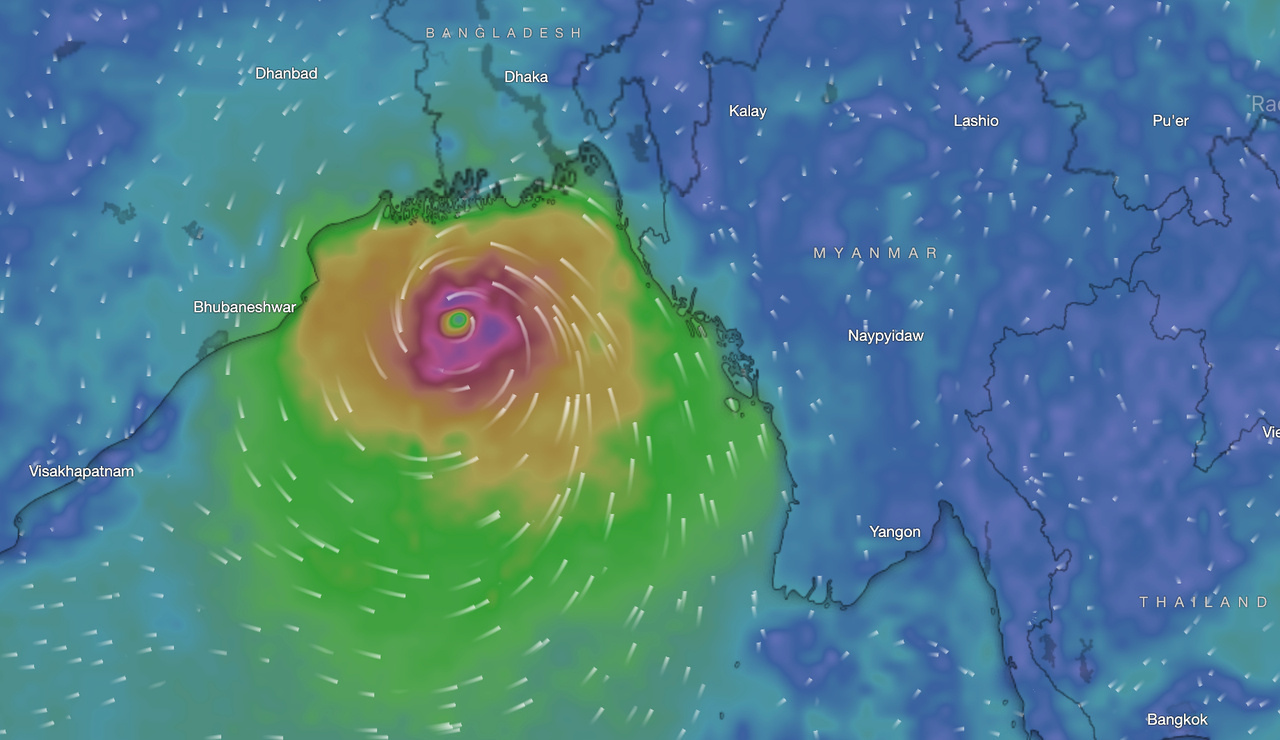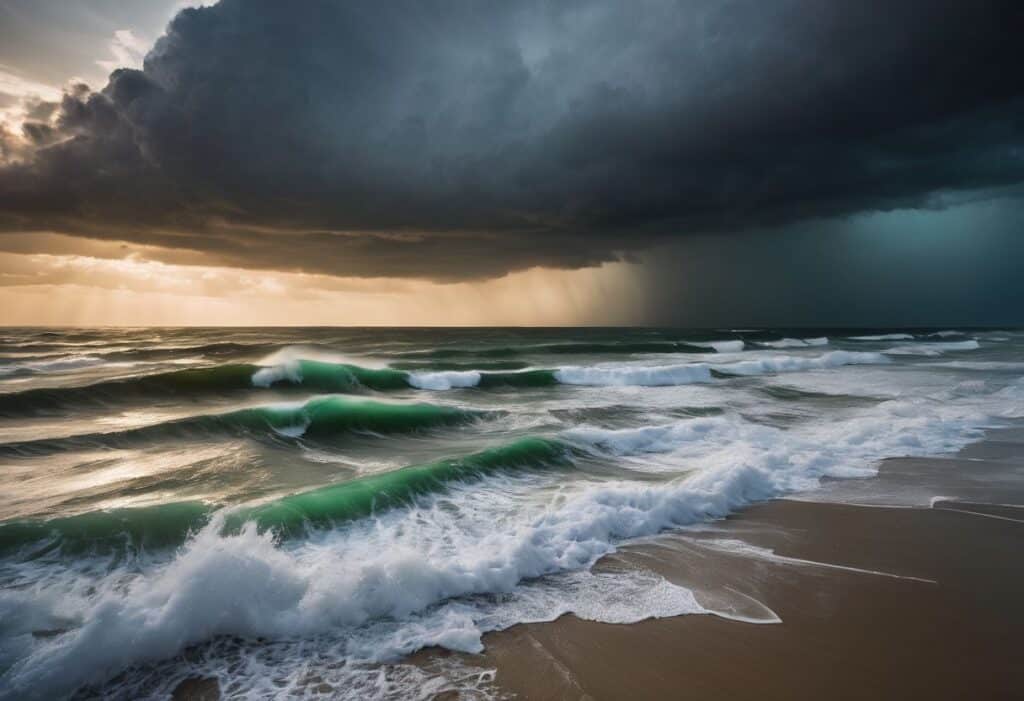As Cyclone Hamoon edges closer to the coast of Bangladesh, many residents may feel anxious about what this means for them and their communities. Known as a severe cyclonic storm, it forms over the northwest bay and has generated significant concern. Cyclone Hamoon in Bangladesh is trending news currently.
This content is designed to keep you informed with all the latest updates surrounding Cyclone Hamoon, including its predicted track, impact on life and property, safety measures in place, and much more.
Stick around as we unravel everything you need to know. Buckle up for a thorough analysis that helps turn fear into preparedness.
Maritime ports of Chattogram and Payra have been advised to hoist danger Signal 7, while Cox’s Bazar and Mongla ports have been asked to hoist danger Signal 6 and 5, respectively, as cyclonic storm “Hamoon” has intensified into a severe cyclonic storm over the northwest Bay.
Content Highlights
- Cyclone Hamoon is a severe cyclonic storm that has formed in the Bay of Bengal and is headed towards Bangladesh.
- It originated from a low-pressure area over the Andaman Sea and has intensified into a cyclonic storm.
- The cyclone is expected to land near Bhola tomorrow morning, bringing heavy rainfall and strong winds.
- Safety measures, including evacuation efforts, are underway in coastal districts to protect vulnerable communities.
What is Cyclone Hamoon and How Did It Form?
Cyclone Hamoon is a severe cyclonic storm that has formed in the Bay of Bengal and is headed towards Bangladesh. It originated from a low-pressure area over the Andaman Sea, which gradually intensified into a depression and then further intensified into a cyclonic storm.
Origin and track of the cyclone
Cyclone Hamoon started as a storm over the northwest bay. It quickly grew into a big cyclone. It moved along a path that took it to many places. First, it was 445 kilometers west-southwest of Chattogram port.
Then it moved to be about 410 kilometers west-southwest of Cox’s Bazar port. After that, it went about 325 kilometers southwest of Mongla Port. Last, it ended up around 310 kilometers southwest of Payra port.
Classification as a severe cyclonic storm
Cyclone Hamoon is now a severe cyclonic storm. It gained this status because of its strength and speed. The winds are very fast, pushing the waves in the sea high into the sky.
It is found in the northwest bay, far from land. Cyclone Hamoon stays mostly over water, which gives it power. The storm is miles away from ports like Chattogram, Cox’s Bazar, and Mongla.

Impact of Cyclone Hamoon on Bangladesh
Cyclone Hamoon has significantly impacted Bangladesh, with authorities issuing warnings to residents and outlining expected landfall dates and locations. The potential for damage is high, making safety precautions essential for the affected areas.
Warning issued by authorities
The storm is now bigger and stronger. It goes by the name of Cyclone Hamoon. The people in charge have said it can be dangerous. They have given a danger signal of seven for some places near the coast.
These areas are Barishal, Patuakhali, Bhola, Barguna, Pirojpur, Jhalakati, Chattogram, Feni, Noakhali, Laxmipur, and Chandpur. This also includes islands out at sea from these places.
A lot of rain with strong winds may hit these places because of the storm. “It is likely to move north-northeastward and may cross the Barishal-Chattogram coast near Bhola by tomorrow morning as a cyclonic storm,” it said.
The bulletin said the maximum sustained wind speed within 64 kilometres of the storm center is about 90 kilometres per hour, rising to 110 kilometres per hour in gusts/squalls. “Sea will remain high near the severe cyclone center.”
Expected landfall date and location
Cyclone Hamoon is expected to make landfall in Bangladesh tomorrow morning. It is predicted to cross the Barishal-Chattogram coast near Bhola. Barishal, Patuakhali, Bhola, and Chattogram coastal districts have been issued danger signal number seven.
Heavy rainfall with gusts or squally wind is anticipated in Bangladesh’s north Bay and coastal areas.
Potential damage and safety precautions
Cyclone Hamoon is expected to cause potential damage along the coastal areas of Bangladesh. The cyclone could bring heavy rainfall and strong winds, flooding low-lying areas.
Coastal districts may experience danger signal number seven, indicating severe weather conditions. To ensure safety, residents in these areas need to follow the guidance provided by local authorities and evacuate if necessary.
Precautions such as securing loose objects, staying away from beaches or riverbanks, and being prepared with essential supplies can help minimize risks during the cyclone. Stay updated on the latest information from reliable sources and take proactive measures to ensure personal safety and protect property.
Real-Time Updates from windy.com
Key Updates on Cyclone Hamoon
As of the latest updates from the Bangladesh Meteorological Department (BMD), Cyclone Hamoon is expected to make landfall in Bangladesh on [date]. Efforts for evacuation and safety measures are underway, with neighboring countries also bracing for its impact.
Latest update from Bangladesh Meteorological Department (BMD)
According to the Bangladesh Meteorological Department, the severe cyclonic storm is about 445 kilometers west-southwest of Chattogram port, 410 kilometers west-southwest of Cox’s Bazar port, 325 kilometers southwest of Mongla port, and 310 kilometers southwest of Payra port.
The BMD bulletin said the coastal districts of Barishal, Patuakhali, Bhola, Barguna, Pirojpur, Jhalakati, Chattogram, Feni, Noakhali, Laxmipur, Chandpur, and their offshore islands and chars would come into danger signal no. 7.
It said that due to the cyclonic storm, heavy rainfall with gusts and squally wind may continue over Bangladesh’s north bay and coastal areas.
The low-lying areas of the coastal districts of Cox’s Bazar, Chattogram, Noakhali, Laxmipur, Feni, Chandpur, Barguna, Bhola, Patuakhali, Barishal, Pirojpur, Jhalakati, Bagerhat, Khulna, Satkhira, and their offshore islands and chars are likely to be inundated by a wind-driven surge of 3-5 feet above normal astronomical tide.
Under the influence of the severe cyclone, Dhaka, Khulna, Barishal, Chattogram, and Sylhet divisions are likely to experience heavy to very heavy rainfall.
Evacuation efforts and measures
Authorities in Bangladesh have taken swift action to ensure the safety of residents in the path of Cyclone Hamoon. Evacuation efforts are underway in coastal districts, including Barishal, Patuakhali, Bhola, Barguna, Pirojpur, Jhalakati, Chattogram, Feni, Noakhali, and Laxmipur.
The aim is to move people out of vulnerable areas before the cyclone lands. Low-lying regions are most at risk and may be inundated by a surge of up to 5 feet above normal tide levels.
Safety measures such as warning signals and advisories have also been issued to help communities prepare for this severe weather event. Everyone in affected areas must follow evacuation plans and instructions from local authorities to stay safe amidst this dangerous storm.
 Impact on neighboring countries
Impact on neighboring countries
Cyclone Hamoon not only affects Bangladesh but also has an impact on neighboring countries. The strong winds and heavy rainfall can cause damage to infrastructure, homes, and crops in these areas.
Additionally, the cyclone can lead to flooding and landslides, posing further risks to people’s safety. Countries close to Bangladesh need to be prepared for these potential consequences and take appropriate measures to mitigate the effects of Cyclone Hamoon.
All nations in the region need to work together and support each other during natural disasters for a better chance of recovery and resilience.
Importance of Preparedness and Safety Measures
To minimize the impact of Cyclone Hamoon on Bangladesh, individuals and authorities must prioritize preparedness and safety measures. By learning from previous cyclones and recognizing the importance of timely information, proactive actions can be taken to ensure the safety of vulnerable communities.
With effective emergency preparedness plans, including evacuation strategies, lives can be saved, and potential damage can be minimized. Read on to discover more about how Bangladesh prepares for Cyclone Hamoon and why being well-prepared is essential in facing such natural disasters.
Learnings from previous cyclones
Previous cyclones have taught us valuable lessons about preparedness and safety measures. We now understand that timely information and proactive actions are crucial in minimizing the impact of these natural disasters.
By learning from past experiences, we can develop emergency preparedness plans and implement effective evacuation strategies to safeguard lives and property.
It is important to stay informed about the latest updates from credible sources like the Bangladesh Meteorological Department (BMD) and follow the guidance provided by authorities to ensure our safety during such events.
Importance of timely information and proactive actions
It’s important to stay informed and take action regarding cyclones like Hamoon. Timely information can help us understand the severity of the situation and take necessary precautions.
Proactively, we can protect ourselves, our families, and our communities from harm. We can learn from past experiences and implement emergency preparedness plans. It’s crucial to listen to official warnings, follow safety guidelines, and evacuate if instructed.
With timely information and proactive actions, we can minimize the impact of cyclones and ensure the safety of everyone involved.
Emergency preparedness and evacuation plans
During a cyclone like Cyclone Hamoon, it is crucial to be prepared and have an evacuation plan in place. This includes having emergency supplies such as food, water, flashlights, and batteries.
It’s important to know the nearest evacuation shelters and routes to move to safety if needed quickly.
Authorities will provide warnings and updates on the cyclone’s expected landfall date and location. It is essential to listen carefully to these alerts and follow instructions from local authorities.
They may issue danger signals for specific coastal districts or advise certain areas to evacuate.
Based on the latest information from the Bangladesh Meteorological Department (BMD), efforts are being made to evacuate people living in low-lying areas prone to flooding or landslides due to heavy rainfall.
Takeaway
In conclusion, Cyclone Hamoon has intensified into a severe cyclonic storm and is expected to land near Bhola tomorrow morning. Coastal districts in Bangladesh will experience danger signal number seven and heavy rainfall with gusts and squally wind.
People need to be prepared and follow safety measures to minimize the potential damage caused by the cyclone. Stay updated with information from reliable sources and take proactive actions to ensure your safety during this time.
Frequently Asked Questions (FAQs) on Cyclone Hamoon in Bangladesh
1. What is Cyclone Hamoon?
Cyclone Hamoon is a severe weather system characterized by strong winds and heavy rainfall that can cause significant damage to coastal areas.
2. Where is Cyclone Hamoon currently located?
The location of Cyclone Hamoon may change over time, so it’s best to refer to reliable news sources or the local meteorological department for the latest updates on its whereabouts.
3. How can I stay safe during Cyclone Hamoon?
To stay safe during Cyclone Hamoon, follow the instructions and warnings provided by local authorities, evacuate if necessary, seek shelter in sturdy buildings away from coastlines, and avoid going outside until it is deemed safe.
4. Are there any travel restrictions due to Cyclone Hamoon in Bangladesh?
Travel restrictions may be imposed during cyclones for safety reasons. It’s important to check with relevant authorities or transportation providers for information on any travel advisories or disruptions caused by Cyclone Hamoon.
5. What are the potential impacts of Cyclone Hamoon in Bangladesh?
Potential impacts of Cyclone Hamoon in Bangladesh include heavy rains leading to flooding, strong winds causing structural damage and power outages, and potentially hazardous sea conditions along coastal areas.



 Impact on neighboring countries
Impact on neighboring countries




































